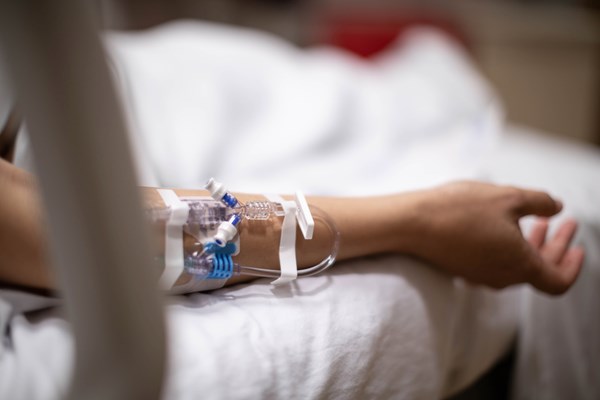Introduction
Ceftriaxone (Rocephin) is a third-generation cephalosporin that is widely used in the treatment of various infections in emergency departments. It is indicated for infections of the skin and soft tissue, intra-abdominal, urinary tract, those that are sexually transmitted as well as community acquired pneumonia.1 Although comprehensive data on Rocephin utilization is limited, previous prospective studies have reported hospital utilization rates as high as 61%.2 The widespread use of Rocephin is attributed to its broad-spectrum antimicrobial coverage and low incidence of adverse side effects compared to others with its same coverage. Although rare, side effects associated with Rocephin use include dermatologic, gastrointestinal, and hypersensitivity reactions. Hypersensitivity reactions, including anaphylaxis and serum sickness, account for less than 1% of cases.1 The Alabama Department of Public Health and Pennsylvania Department of Health have recently issued health advisories regarding serious adverse events following Rocephin administration.3,4
Case Presentation
This case involves a 56-year-old Caucasian female with a past medical history of hypertension (HTN), chronic obstructive pulmonary disease (COPD), congestive heart failure (CHF), chronic back pain and spasticity requiring intrathecal baclofen pump, scoliosis, and bipolar 1 disorder. She presented to the emergency department with a chief complaint of abdominal pain, diarrhea, and urinary retention. The patient reported that her symptoms had been present for over three months. She had recently been evaluated at an outside facility for similar complaints; at that time, there were concerns of cord compression which was effectively ruled out. A prior computed tomography (CT) scan of the abdomen revealed a distended urinary bladder but no acute intra-abdominal pathology. Of note, the patient had received multiple doses of Rocephin for a urinary tract infection (UTI) during her hospitalization at an outside facility just one month prior.
Her past surgical history included shoulder replacement, tonsillectomy, laminectomy, hysterectomy, appendectomy, and baclofen pump implantation. Medication list includes furosemide, baclofen, Sumatriptan, omeprazole, metoprolol, lisinopril, alprazolam, bupropion, Latuda, Percocet, gabapentin, clonidine, Imdur, and aspirin. Documented allergies included bee venom protein, tissue adhesive, and vancomycin.
On presentation, the patient was hemodynamically stable. Physical exam was notable for diffuse abdominal tenderness. Labs were significant for leukocytosis, hypomagnesaemia, and hyponatremia. Urinalysis was consistent with a urinary tract infection. CT imaging of the abdomen and pelvis showed evidence of inflammation concerning for infectious colitis. These findings led to the administration of intravenous Rocephin for suspected UTI and infectious colitis. Shortly after Rocephin began infusing, the patient was complaining of a sore throat and, within seconds, the patient became unresponsive and pulseless. Cardiopulmonary resuscitation (CPR) was initiated. Physical examination during CPR revealed diffuse wheezing, hypotension, as well as perioral and generalized cyanosis which was most prominent in the arm containing her peripheral IV catheter. These findings were consistent with anaphylactic shock. The patient achieved return of spontaneous circulation (ROSC) and was admitted to the ICU requiring epinephrine infusion for anaphylaxis and blood pressure support. Despite resuscitative efforts, her condition deteriorated, and the patient passed away within 24 hours.
Discussion
Rocephin is one of the most commonly used antibiotics in the emergency department and the recent rise in adverse reactions has warranted further investigation. Abodunrin et al. reported a similar case on a patient who went into cardiac arrest immediately after receiving Rocephin for community acquired pneumonia.5 Mustafa et al. had a case of fatal cardiac arrest following Rocephin administration in a pediatric patient and recommended using intravenous infusion to reduce the risk of hypersensitivity reactions.6 These cases further reinforce the need to remain attentive to potential side effects when administering Rocephin. This case should be analyzed in the context of limitations. The patient received intravenous iodine contrast less than 20 minutes prior to antibiotic administration. Of note, the patient did not have any documented history of contrast allergy but an additive or synergistic effect with Rocephin cannot be excluded. Another consideration is the patient’s documented allergies of Vancomycin, tissue adhesive, and bee venom, raising the possibility of a predisposition to hypersensitivity reactions. Further studies are warranted to assess the influence of different routes of administration and the potential benefit of pretreatment strategies in high-risk individuals to minimize adverse events.
Conclusion
Rocephin is routinely used across hospital settings for an array of infections. This case has important clinical implications given the recent rise in reported adverse reactions. While its use will remain a cornerstone in the treatment for its breadth of coverage, adverse reactions—although rare—can still occur. Further data investigating this rise in adverse reactions is warranted. In the meantime, clinicians should remain vigilant for early signs of hypersensitivity, particularly in patients with a known history of allergy susceptibility.
Patient Consent
Informed consent for publication was obtained from the patient’s next of kin.
References
- UpToDate. Ceftriaxone: Drug Information. Published online 2025.
- Ayele AA, Gebresillassie BM, Erku DA, et al. Prospective evaluation of Ceftriaxone use in medical and emergency wards of Gondar university referral hospital, Ethiopia. Pharmacol Res Perspect. 2018;6(1):1-7.
- Alabama Board of Medical Examiners. ADPH Alert-Potential Adverse Events after Injections of Ceftriaxone. Published online 2025.
- Bogen DL (MD/FAAP). Report Serious Adverse Events After Ceftriaxone Administration. Published online 2025.
- Abodunrin F, Ismayl M, Aboeata A, Plambeck R. A case report of ceftriaxone-induced cardiopulmonary arrest. Ann Med Surg. 2022;84(November):104813.
- Ul Mustafa Z, Salman M, Raza MH, et al. Ceftriaxone Induced Cardiopulmonary Arrest: A Fatal Case Report. Arch Pharm Pract. 2021;12(1):115-117.



